Hyper-Localized Pollution Mapping Using Low-Cost Wearable Monitors and Citizen Science in Hong Kong
Abstract
1. Introduction
2. Materials and Methods
2.1. Wearable Strategies
2.2. Data Collection and Measurement
3. Results
3.1. Calibration and Performance Analysis
3.2. PM Exposure Patterns in Different Environments
3.3. Spatial Heterogeneity and Source Contribution
3.4. Hotspot Map and Environmental Justice
4. Discussion
5. Conclusions
Author Contributions
Funding
Data Availability Statement
Conflicts of Interest
References
- Thurston, G.D.; Kipen, H.; Annesi-Maesano, I.; Balmes, J.; Brook, R.D.; Cromar, K.; De Matteis, S.; Forastiere, F.; Forsberg, B.; Frampton, M.W.; et al. A joint ERS/ATS policy statement: What constitutes an adverse health effect of air pollution? An analytical framework. Eur. Respir. J. 2017, 49, 1600419. [Google Scholar] [CrossRef]
- Manu, S.; Rysanek, A. A Co-Location Study of 87 Low-Cost Environmental Monitors: Assessing Outliers, Variability, and Uncertainty. Buildings 2024, 14, 2965. [Google Scholar] [CrossRef]
- Agency, E.E. Europe’s Air Quality Status 2023. Available online: https://www.eea.europa.eu/en/analysis/publications/europes-air-quality-status-2023 (accessed on 25 August 2025).
- Pai, S.J.; Carter, T.S.; Heald, C.L.; Kroll, J.H. Updated World Health Organization Air Quality Guidelines Highlight the Importance of Non-anthropogenic PM(2.5). Environ. Sci. Technol. Lett. 2022, 9, 501–506. [Google Scholar] [CrossRef]
- Sigsgaard, T.; Hoffmann, B. Assessing the health burden from air pollution. Science 2024, 384, 33–34. [Google Scholar] [CrossRef]
- Nie, T.; Zhang, G.F.; Sun, Y.N.; Wang, W.H.; Wang, T.N.; Duan, H.Y. Effects of Indoor Air Quality on Human Physiological Impact: A Review. Buildings 2025, 15, 1296. [Google Scholar] [CrossRef]
- Peters, T.; Zhen, C. Evaluating indoor air quality monitoring devices for healthy homes. Buildings 2023, 14, 102. [Google Scholar] [CrossRef]
- Heaney, A.; Stowell, J.D.; Liu, J.C.; Basu, R.; Marlier, M.; Kinney, P. Impacts of Fine Particulate Matter from Wildfire Smoke on Respiratory and Cardiovascular Health in California. Geohealth 2022, 6, e2021GH000578. [Google Scholar] [CrossRef]
- Sun, C.J.; Wang, Q.H.; Zhang, J.L.; Zou, Z.J.; He, X.W.; Niu, J.L.; Wang, H.D.; Su, C.X.; Lu, R.C.; Huang, B.J.; et al. Cancer risk and sick building syndrome in different regions of China: Potential hazard from particulate matter and phthalate pollutants. Sustain. Cities Soc. 2025, 124, 106297. [Google Scholar] [CrossRef]
- Zhang, Y.Q.; Wei, J.; Chen, S.R.; Benmarhnia, T.; Zhang, K.; Wang, X.W.; Deng, X.L.; Gu, H.G.; Lin, Z.Q.; Qu, Y.J.; et al. Individual and mixed associations between fine particulate matter components and hospital admissions for hypertension: Insights from a large-scale South Chinese cohort study. Sustain. Cities Soc. 2025, 124, 106293. [Google Scholar] [CrossRef]
- Noble, C.A.; Vanderpool, R.W.; Peters, T.M.; McElroy, F.F.; Gemmill, D.B.; Wiener, R.W. Federal reference and equivalent methods for measuring fine particulate matter. Aerosol Sci. Technol. 2001, 34, 457–464. [Google Scholar] [CrossRef]
- Morawska, L.; Asbach, C.; Patel, H. Application of PM low-cost sensors for indoor air quality compliance monitoring. Aerosol Sci. Technol. 2025, 1–11. [Google Scholar] [CrossRef]
- Zhang, H.; Evangelopoulos, D.; Wood, D.; Chatzidiakou, L.; Varaden, D.; Quint, J.; de Nazelle, A.; Walton, H.; Katsouyanni, K.; Barratt, B. Estimating exposure to pollutants generated from indoor and outdoor sources within vulnerable populations using personal air quality monitors: A London case study. Environ. Int. 2025, 198, 109431. [Google Scholar] [CrossRef] [PubMed]
- Vishal; Sharma, M.; Jain, S. Unmanned aerial vehicles and low-cost sensors for air quality monitoring: A comprehensive review of applications across diverse emission sources. Sustain. Cities Soc. 2025, 127, 106409. [Google Scholar] [CrossRef]
- Hassani, A.; Castell, N.; Watne, A.K.; Schneider, P. Citizen-operated mobile low-cost sensors for urban PM monitoring: Field calibration, uncertainty estimation, and application. Sustain. Cities Soc. 2023, 95, 104607. [Google Scholar] [CrossRef]
- Hankey, S.; Sforza, P.; Pierson, M. Using Mobile Monitoring to Develop Hourly Empirical Models of Particulate Air Pollution in a Rural Appalachian Community. Environ. Sci. Technol. 2019, 53, 4305–4315. [Google Scholar] [CrossRef]
- Mueller, M.D.; Hasenfratz, D.; Saukh, O.; Fierz, M.; Hueglin, C. Statistical modelling of particle number concentration in Zurich at high spatio-temporal resolution utilizing data from a mobile sensor network. Atmos. Environ. 2016, 126, 171–181. [Google Scholar] [CrossRef]
- Sun, Y.; Brimblecombe, P.; Wei, P.; Duan, Y.; Pan, J.; Liu, Q.; Fu, Q.; Peng, Z.; Xu, S.; Wang, Y.; et al. High Resolution On-Road Air Pollution Using a Large Taxi-Based Mobile Sensor Network. Sensors 2022, 22, 6005. [Google Scholar] [CrossRef]
- Zheng, T.S.; Bergin, M.H.; Johnson, K.K.; Tripathi, S.N.; Shirodkar, S.; Landis, M.S.; Sutaria, R.; Carlson, D.E. Field evaluation of low-cost particulate matter sensors in high-and low-concentration environments. Atmos. Meas. Tech. 2018, 11, 4823–4846. [Google Scholar] [CrossRef]
- Badura, M.; Batog, P.; Drzeniecka-Osiadacz, A.; Modzel, P. Evaluation of Low-Cost Sensors for Ambient PM2.5 Monitoring. J. Sensors 2018, 2018, 5096540. [Google Scholar] [CrossRef]
- Hofman, J.; Lazarov, B.; Stroobants, C.; Elst, E.; Smets, I.; Van Poppel, M. Portable Sensors for Dynamic Exposure Assessments in Urban Environments: State of the Science. Sensors 2024, 24, 5653. [Google Scholar] [CrossRef]
- Li, X.; Wei, Y.; Zhang, J.; Jin, P. Design and analysis of an active daylight harvesting system for building. Renew. Energy 2019, 139, 670–678. [Google Scholar] [CrossRef]
- Cheriyan, D.; Choi, J.H. Estimation of particulate matter exposure to construction workers using low-cost dust sensors. Sustain. Cities Soc. 2020, 59, 102197. [Google Scholar] [CrossRef]
- Ruiter, S.; Bard, D.; Ben Jeddi, H.; Saunders, J.; Snawder, J.; Warren, N.; Gorce, J.P.; Cauda, E.; Kuijpers, E.; Pronk, A. Exposure Monitoring Strategies for Applying Low-Cost PM Sensors to Assess Flour Dust in Industrial Bakeries. Ann. Work Expo. Health 2023, 67, 379–391. [Google Scholar] [CrossRef] [PubMed]
- Kang, Y.; Aye, L.; Ngo, T.D.; Zhou, J. Performance evaluation of low-cost air quality sensors: A review. Sci. Total Environ. 2022, 818, 151769. [Google Scholar] [CrossRef] [PubMed]
- Li, X.; Mak, C.M.; Ai, Z.; Wong, H.M. Airborne transmission of exhaled pollutants during short-term events: Quantitatively assessing inhalation monitor points. Build. Environ. 2022, 223, 109487. [Google Scholar] [CrossRef]
- Chiliński, M.T.; Broda, M.; Nurowska, K.; Markowicz, K. The Near-Surface Vertical Variability of Aerosol Single-Scattering Properties over Warsaw: Case Study. Aerosol Air Qual. Res. 2025, 25, 14. [Google Scholar] [CrossRef]
- Pérez, A.P.; Fernández, E.I.; Shah, S.M.A.; Casado-Mansilla, D.; Valera, A.J.J.; López-De-Ipiña, D. Performance assessment of wearable atmotube pro sensor for air quality citizen science applications. In Proceedings of the 2024 9th International Conference on Smart and Sustainable Technologies (SpliTech), Bol and Split, Croatia, 25–28 June 2024; pp. 1–6. [Google Scholar] [CrossRef]
- Shittu, A.; Pringle, K.; Arnold, S.; Pope, R.; Graham, A.; Reddington, C.; Rigby, R.; McQuaid, J. Performance Evaluation of Atmotube Pro sensors for Air Quality Measurements. EGUsphere 2024, 2024, 1–17. [Google Scholar] [CrossRef]
- Steinle, S.; Reis, S.; Sabel, C.E.; Semple, S.; Twigg, M.M.; Braban, C.F.; Leeson, S.R.; Heal, M.R.; Harrison, D.; Lin, C. Personal exposure monitoring of PM2. 5 in indoor and outdoor microenvironments. Sci. Total Environ. 2015, 508, 383–394. [Google Scholar] [CrossRef] [PubMed]
- Sloan, C.D.; Philipp, T.J.; Bradshaw, R.K.; Chronister, S.; Barber, W.B.; Johnston, J.D. Applications of GPS-tracked personal and fixed-location PM2.5 continuous exposure monitoring. J. Air Waste Manag. 2016, 66, 53–65. [Google Scholar] [CrossRef]
- Clements, A.; Duvall, R.; Greene, D.; Dye, T. The Enhanced Air Sensor Guidebook. Available online: https://www.epa.gov/air-sensor-toolbox/how-use-air-sensors-air-sensor-guidebook (accessed on 29 August 2025).
- Zimmerman, N. Tutorial: Guidelines for implementing low-cost sensor networks for aerosol monitoring. J. Aerosol. Sci. 2022, 159, 105872. [Google Scholar] [CrossRef]
- Lee, H.; Kang, J.; Kim, S.; Im, Y.; Yoo, S.; Lee, D. Long-Term Evaluation and Calibration of Low-Cost Particulate Matter (PM) Sensor. Sensors 2020, 20, 3617. [Google Scholar] [CrossRef]
- Romero, Y.; Velasquez, R.M.A.; Noel, J. Development of a multiple regression model to calibrate a low-cost sensor considering reference measurements and meteorological parameters. Environ. Monit. Assess. 2020, 192, 498. [Google Scholar] [CrossRef] [PubMed]
- Stavroulas, I.; Grivas, G.; Michalopoulos, P.; Liakakou, E.; Bougiatioti, A.; Kalkavouras, P.; Fameli, K.M.; Hatzianastassiou, N.; Mihalopoulos, N.; Gerasopoulos, E. Field Evaluation of Low-Cost PM Sensors (Purple Air PA-II) Under Variable Urban Air Quality Conditions, in Greece. Atmosphere 2020, 11, 926. [Google Scholar] [CrossRef]
- Mai, C.; Wang, Z.; Chen, L.; Huang, Y.; Li, M.; Shirazi, A.; Altaee, A.; Zhou, J.L. Field-based Calibration and Operation of Low-Cost Sensors for Particulate Matter by Linear and Nonlinear Methods. Atmos. Pollut. Res. 2025, 16, 102676. [Google Scholar] [CrossRef]
- Molina Rueda, E.; Carter, E.; L’Orange, C.; Quinn, C.; Volckens, J. Size-Resolved Field Performance of Low-Cost Sensors for Particulate Matter Air Pollution. Environ. Sci. Technol. Lett. 2023, 10, 247–253. [Google Scholar] [CrossRef]
- Air Quality Sensor Performance Evaluation Center Evaluation Summary: Atmotube Pro. Available online: http://www.aqmd.gov/docs/default-source/aq-spec/summary/atmotube-pro---summary-report.pdf?sfvrsn=8 (accessed on 24 August 2025).
- Cox, N.J. Kernel estimation as a basic tool for geomorphological data analysis. Earth Surf. Proc. Land. 2007, 32, 1902–1912. [Google Scholar] [CrossRef]
- Kloog, I.; Ridgway, B.; Koutrakis, P.; Coull, B.A.; Schwartz, J.D. Long- and short-term exposure to PM2.5 and mortality: Using novel exposure models. Epidemiology 2013, 24, 555–561. [Google Scholar] [CrossRef] [PubMed]
- Li, X.; Ai, Z.; Ye, J.; Mak, C.M.; Wong, H.M. Airborne transmission during short-term events: Direct route over indirect route. Build. Simul. 2022, 15, 2097–2110. [Google Scholar] [CrossRef]
- Chaney, R.A.; Sloan, C.D.; Cooper, V.C.; Robinson, D.R.; Hendrickson, N.R.; McCord, T.A.; Johnston, J.D. Personal exposure to fine particulate air pollution while commuting: An examination of six transport modes on an urban arterial roadway. PLoS ONE 2017, 12, e0188053. [Google Scholar] [CrossRef]
- Ramel-Delobel, M.; Peruzzi, C.; Coudon, T.; De Vito, S.; Fattoruso, G.; Praud, D.; Fervers, B.; Salizzoni, P. Exposure to airborne particulate matter during commuting using portable sensors: Effects of transport modes in a French metropolis study case. J. Environ. Manag. 2024, 365, 121400. [Google Scholar] [CrossRef]
- Tham, K.W. Indoor air quality and its effects on humans—A review of challenges and developments in the last 30 years. Energy Build. 2016, 130, 637–650. [Google Scholar] [CrossRef]
- Li, X.; Mak, C.M.; Ai, Z.; Ma, K.W.; Wong, H.M. Cross-infection risk assessment in dental clinic: Numerical investigation of emitted droplets during different atomization procedures. J. Build. Eng. 2023, 75, 106961. [Google Scholar] [CrossRef]
- Cheng, S.; Lam, K.-c. An analysis of winds affecting air pollution concentrations in Hong Kong. Atmos. Environ. 1998, 32, 2559–2567. [Google Scholar] [CrossRef]
- Huang, X.-F.; Yu, J.Z.; Yuan, Z.; Lau, A.K.; Louie, P.K. Source analysis of high particulate matter days in Hong Kong. Atmos. Environ. 2009, 43, 1196–1203. [Google Scholar] [CrossRef]
- Ho, K.; Lee, S.; Jimmy, C.Y.; Zou, S.; Fung, K. Carbonaceous characteristics of atmospheric particulate matter in Hong Kong. Sci. Total Environ. 2002, 300, 59–67. [Google Scholar] [CrossRef]
- Chan, L.; Kwok, W.; Chan, C. Study of Participate at the Roadside Microenvironment in Different Land Use Areas in Hong Kong. WIT Trans. Ecol. Environ. 2024, 28, 9. [Google Scholar] [CrossRef]
- Leung, D.M.; Tai, A.P.; Mickley, L.J.; Moch, J.M.; Van Donkelaar, A.; Shen, L.; Martin, R.V. Synoptic meteorological modes of variability for fine particulate matter (PM 2.5) air quality in major metropolitan regions of China. Atmos. Chem. Phys. 2018, 18, 6733–6748. [Google Scholar] [CrossRef]
- Dai, Y.W.; Mak, C.M.; Ai, Z.T.; Hang, J. Evaluation of computational and physical parameters influencing CFD simulations of pollutant dispersion in building arrays. Build. Environ. 2018, 137, 90–107. [Google Scholar] [CrossRef]
- Dai, Y.W.; Tu, W.L.; Zhang, X.Y.; Li, J.Z.; Yue, X.P.; Wang, H.D. Dynamic wind patterns and indoor/outdoor pollutant dispersion in the simplified building array: Statistical and spectral analyses from scaled outdoor experiments. Build. Environ. 2025, 276, 112861. [Google Scholar] [CrossRef]
- Air Science Group, Environmental Protection Department. Air Quality in Hong Kong 2012. Available online: https://www.aqhi.gov.hk/common/api_history/english/report/files/AQR2012e_final.pdf (accessed on 29 August 2025).
- Apte, J.S.; Manchanda, C. High-resolution urban air pollution mapping. Science 2024, 385, 380–385. [Google Scholar] [CrossRef]
- Li, X.J.; Mak, C.M.; Xue, P.; Xue, R.; Wong, H.M. Unraveling the applicability and thermal performance of PCM-impregnated wood in personalized comfort systems: Thermal manikin verification. Energy Build. 2025, 344, 116028. [Google Scholar] [CrossRef]
- Anik, S.M.H.; Gao, X.H.; Meng, N.R.; Agee, P.P.; McCoy, A. A cost-effective, scalable, and portable IoT data infrastructure for indoor environment sensing. J. Build. Eng. 2022, 49, 104027. [Google Scholar] [CrossRef]
- Ouimette, J.; Arnott, W.P.; Laven, P.; Whitwell, R.; Radhakrishnan, N.; Dhaniyala, S.; Sandink, M.; Tryner, J.; Volckens, J. Fundamentals of low-cost aerosol sensor design and operation. Aerosol Sci. Tech. 2024, 58, 1–15. [Google Scholar] [CrossRef]
- Tang, M.J.; Chan, C.K.; Li, Y.J.; Su, H.; Ma, Q.X.; Wu, Z.J.; Zhang, G.H.; Wang, Z.; Ge, M.F.; Hu, M.; et al. A review of experimental techniques for aerosol hygroscopicity studies. Atmos. Chem. Phys. 2019, 19, 12631–12686. [Google Scholar] [CrossRef]
- Li, X.; Mak, C.M.; Ai, Z.; Ma, K.W.; Wong, H.M. Propagation and evaporation of contaminated droplets, emission and exposure in surgery environments revealed by laser visualization and numerical characterization. J. Hazard. Mater. 2024, 477, 135338. [Google Scholar] [CrossRef] [PubMed]
- Li, X.; Mak, C.M.; Ma, K.W.; Wong, H.M. Evaluating flow-field and expelled droplets in the mockup dental clinic during the COVID-19 pandemic. Phys. Fluids 2021, 33, 047111. [Google Scholar] [CrossRef]
- Li, X.; Mak, C.M.; Ma, K.W.; Wong, H.M. Large eddy simulation study on dental spray dynamics and infection during ultrasonic atomization. J. Build. Eng. 2025, 103, 112164. [Google Scholar] [CrossRef]
- Shittu, A.I.; Pope, R.J.; Pringle, K.J.; Arnold, S.R.; Graham, A.M.; Sideeq, H.O.; Ana, G.R.; McQuaid, J.B. Quantifying Residential Particulate Pollution and Human Exposure in Ibadan, Nigeria, Using Low-Cost Sensors. Aerosol Air Qual. Res. 2025, 25, 44. [Google Scholar] [CrossRef]
- Lanza, K.; Allison, B.; Chen, B.; Wilson, P.S.; Hunt, E.T.; Burford, K.G.; Zhang, Y.; Ganzar, L.A.; Keitt, T.H. Ambient environmental exposures while cycling on a vegetated trail versus the road. Urban Clim. 2025, 61, 102429. [Google Scholar] [CrossRef]
- Feng, Z.; Zheng, L.; Ren, B.; Liu, D.; Huang, J.; Xue, N. Feasibility of low-cost particulate matter sensors for long-term environmental monitoring: Field evaluation and calibration. Sci. Total Environ. 2024, 945, 174089. [Google Scholar] [CrossRef] [PubMed]
- Tang, W.S.; Lee, J.W.; Hui, T.W.; Yip, M.K. The “Urban density” question in Hong Kong: From absolute space to social processes. City Cult. Soc. 2019, 17, 46–53. [Google Scholar] [CrossRef]
- Tan, Y.Y.; Song, J.S.; Yu, L.; Bai, Y.X.; Zhang, J.F.; Chan, M.H.; van Ameijde, J. The Mechanism of Street Markets Fostering Supportive Communities in Old Urban Districts: A Case Study of Sham Shui Po, Hong Kong. Land 2024, 13, 289. [Google Scholar] [CrossRef]
- McNabola, A.; McCreddin, A.; Gill, L.W.; Broderick, B.M. Analysis of the relationship between urban background air pollution concentrations and the personal exposure of office workers in Dublin, Ireland, using baseline separation techniques. Atmos. Pollut. Res. 2011, 2, 80–88. [Google Scholar] [CrossRef]
- Environmental Protection Department, The Government of the Hong Kong Special Administrative Region. Past Air Quality, Mong Kok, Pollutant Concentration. Available online: https://www.aqhi.gov.hk/en/aqhi/past-24-hours-aqhi.html?mid=17 (accessed on 24 August 2025).
- Zhong, X.; Zhang, Z.; Wu, W.; Zhang, R. Estimating space-cooling energy consumption and indoor PM2. 5 exposure across Hong Kong using a city-representative housing stock model. Buildings 2022, 12, 1414. [Google Scholar] [CrossRef]
- Cui, H.; Zhang, L.; Li, W.; Yuan, Z.; Wu, M.; Wang, C.; Ma, J.; Li, Y. A new calibration system for low-cost sensor network in air pollution monitoring. Atmos. Pollut. Res. 2021, 12, 101049. [Google Scholar] [CrossRef]
- Bousiotis, D.; Damayanti, S.; Baruah, A.; Bigi, A.; Beddows, D.C.; Harrison, R.M.; Pope, F.D. Pinpointing sources of pollution using citizen science and hyperlocal low-cost mobile source apportionment. Environ. Int. 2024, 193, 109069. [Google Scholar] [CrossRef] [PubMed]
- Yang, W.; Zhao, B. A real-time personal PM2. 5 exposure monitoring system and its application for college students. Build. Simul. 2024, 17, 1531–1539. [Google Scholar] [CrossRef]
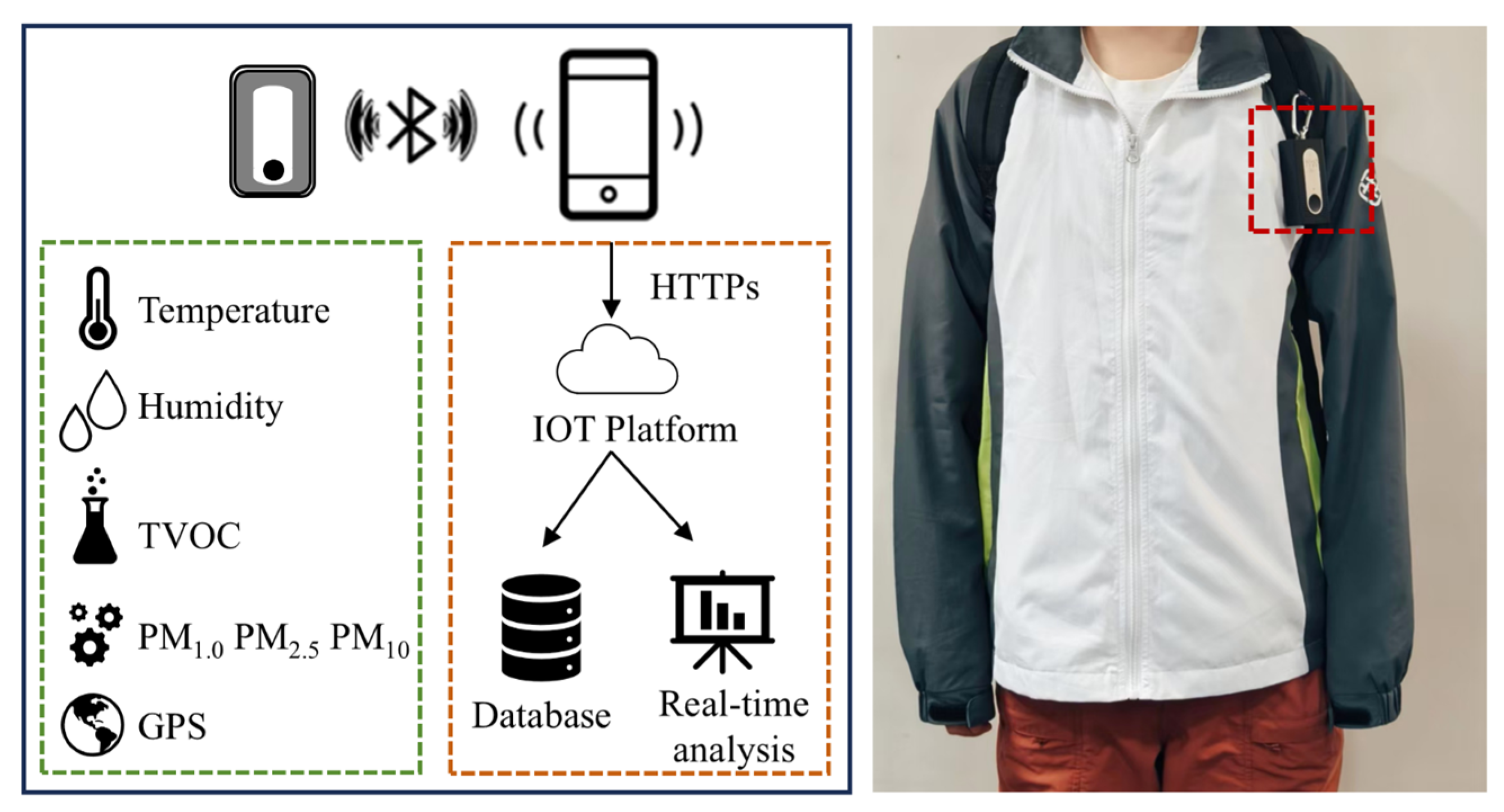
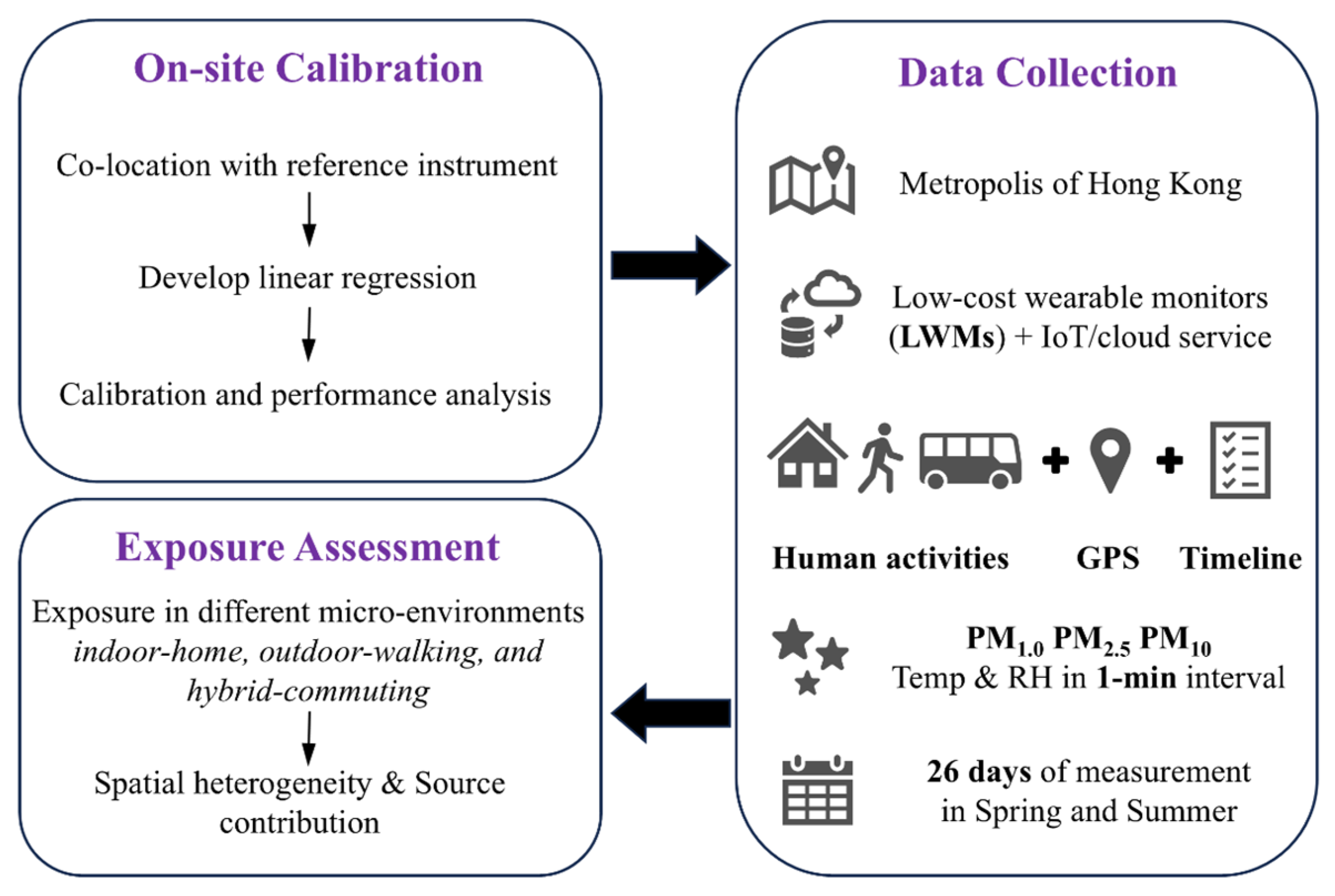
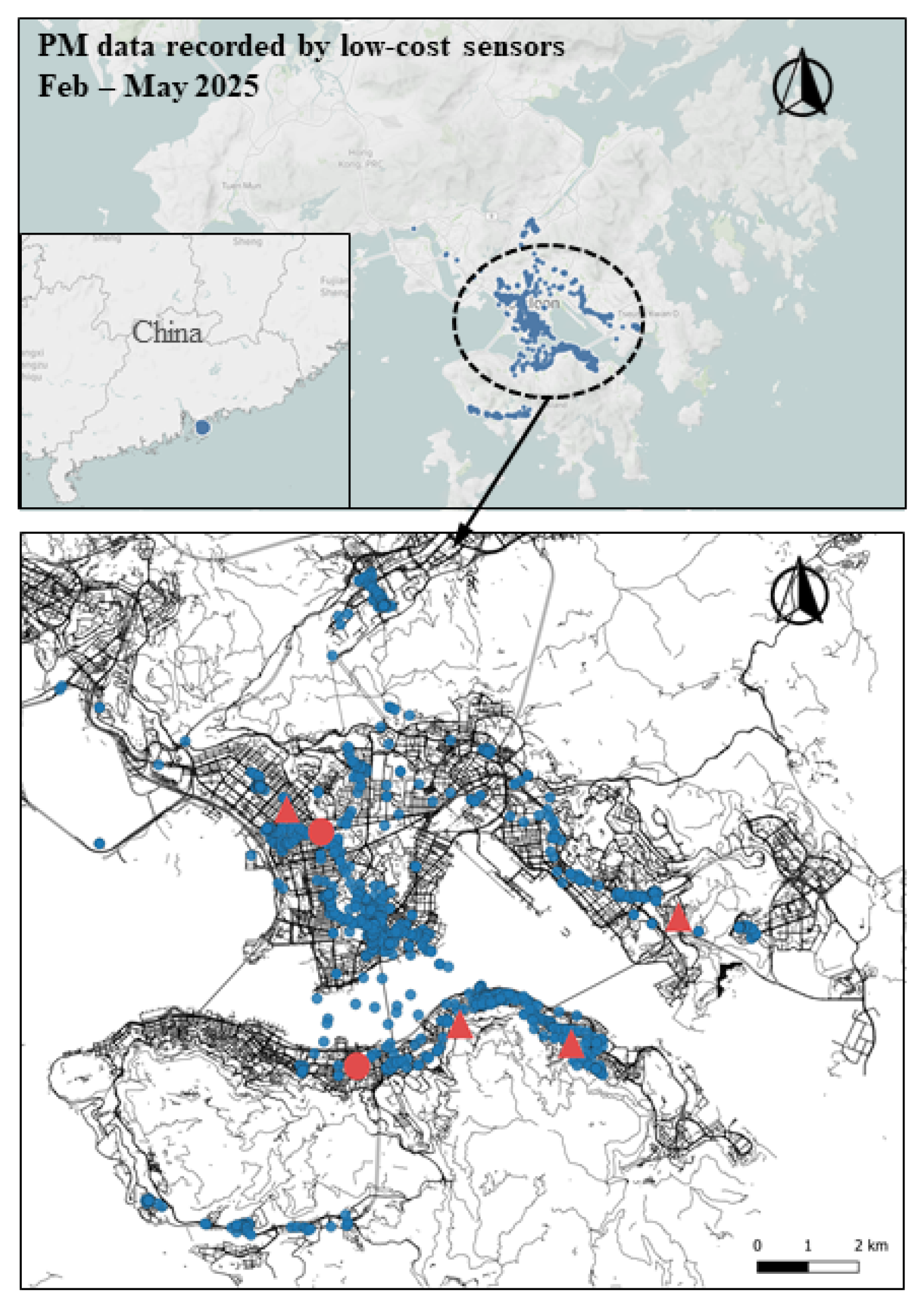
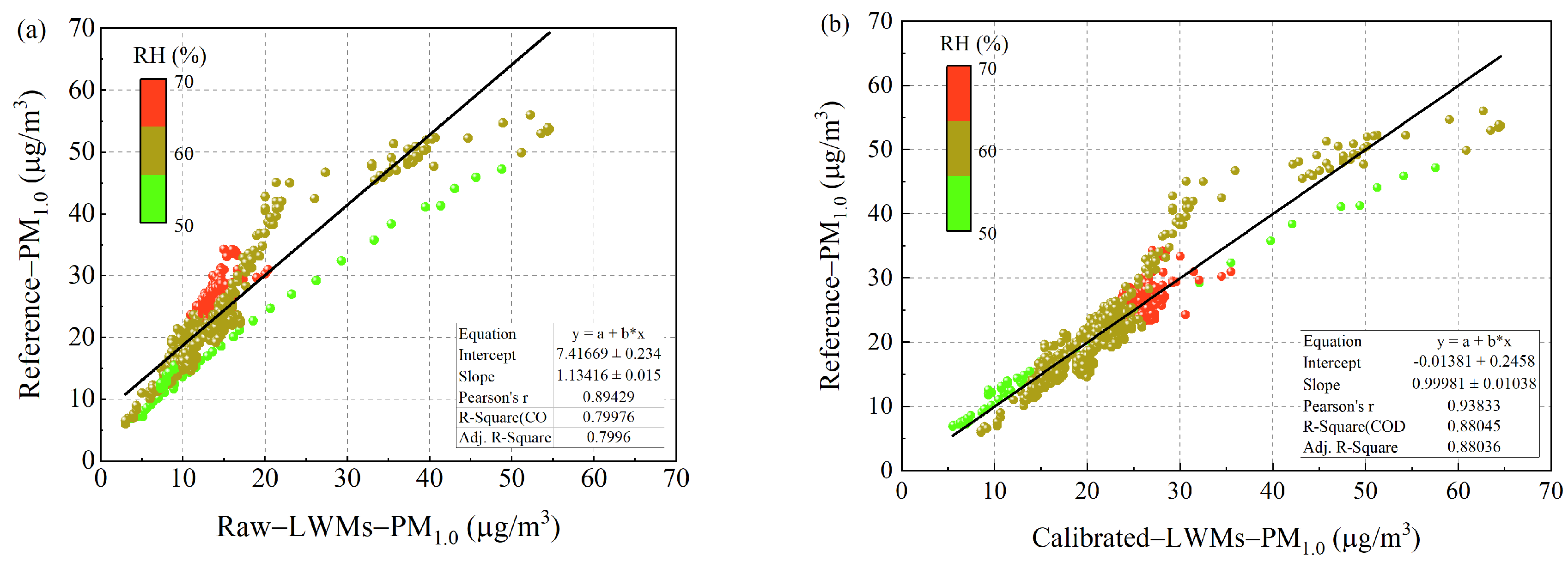

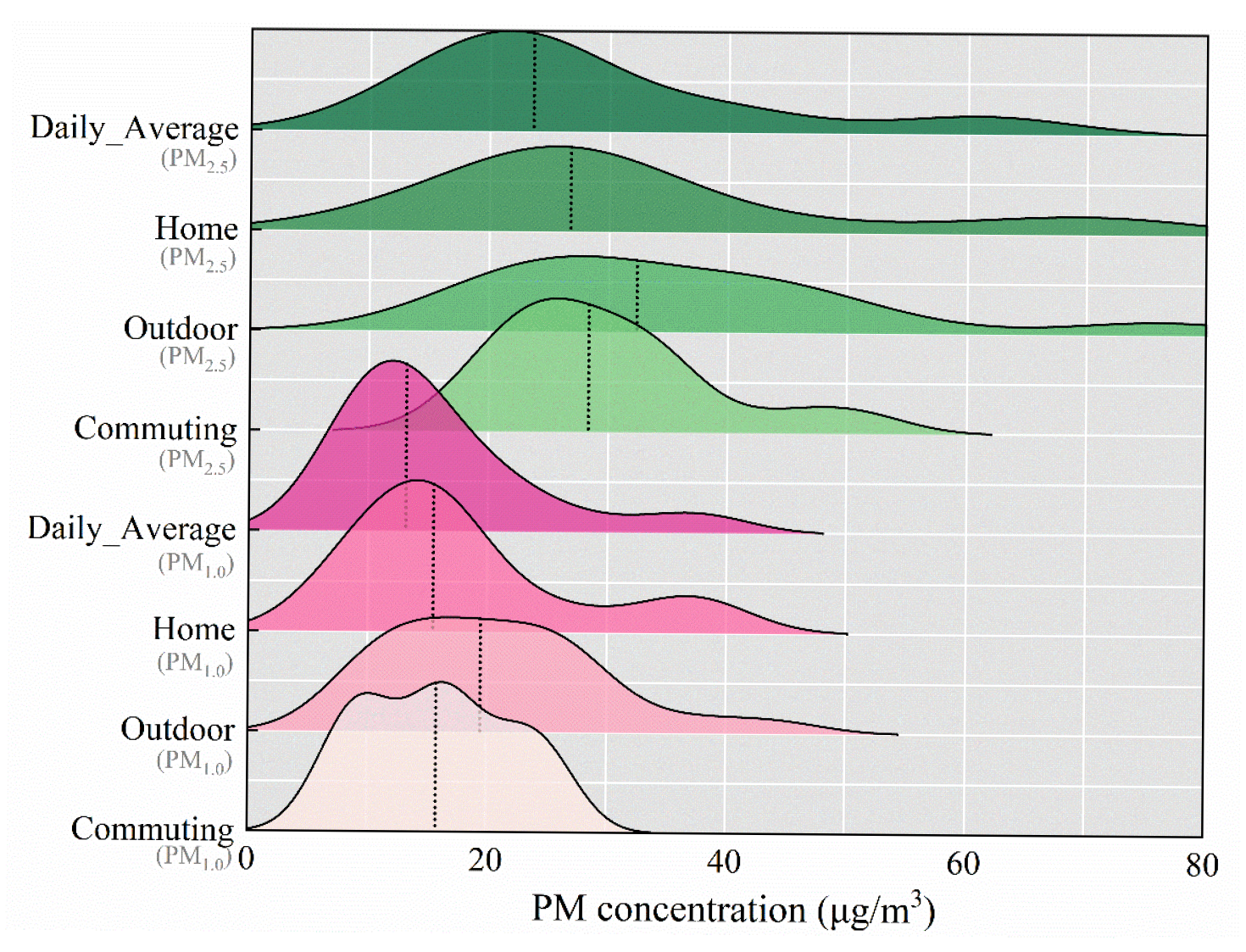

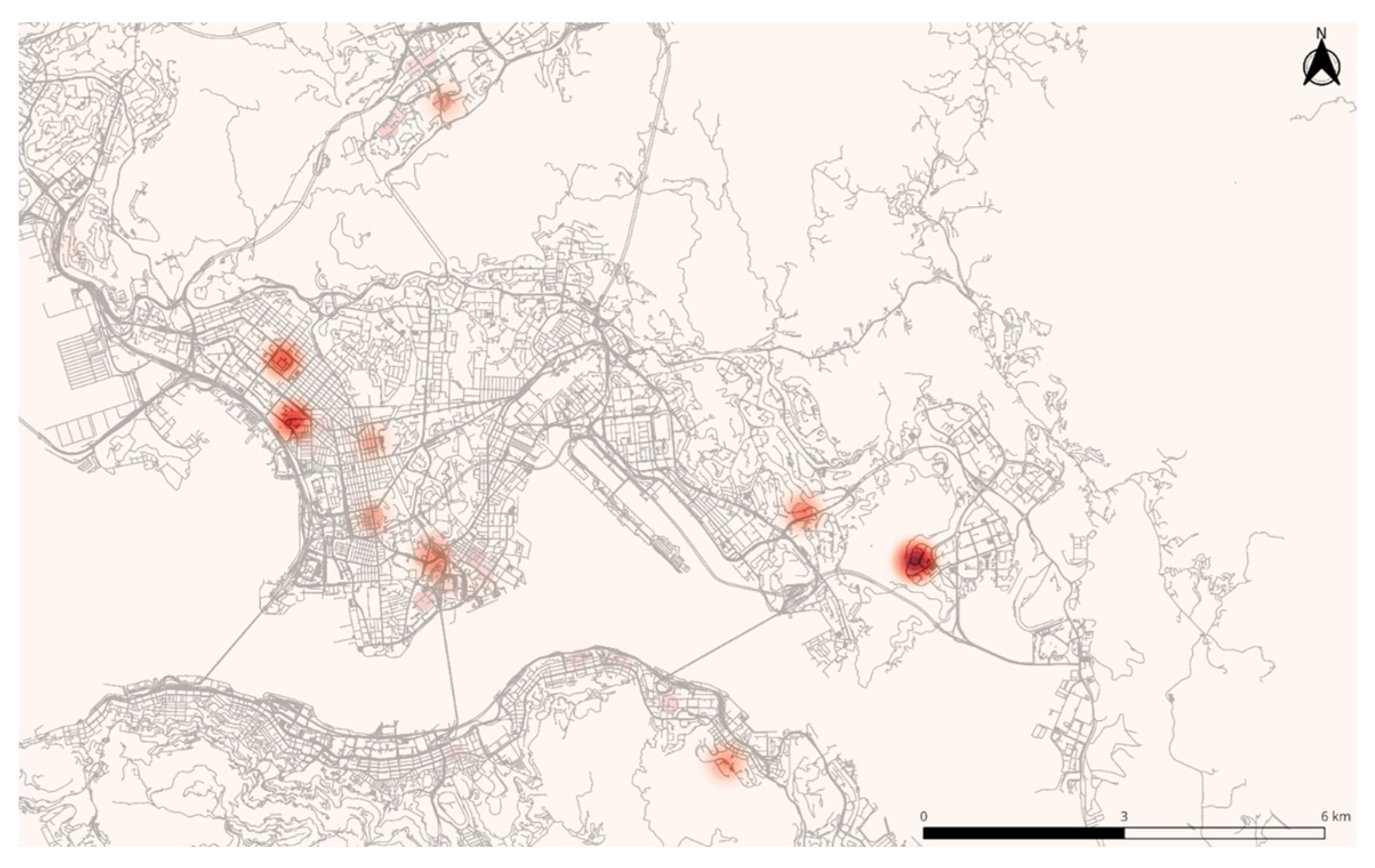
| Sensor | Parameter | Range | Accuracy |
|---|---|---|---|
| Bosch BME280 | Temperature | −40 to 85 °C | ±0.5 °C |
| Bosch BME280 | Humidity | 0 to 100% | ±3% RH |
| Bosch BME280 | Pressure | 300 to 1100 hPa | ±1.7 hPa |
| Sensirion SPS30 | PM1.0, PM2.5, PM10 | 0 to 1000 μg/m3 | 0 to 100 ± 10 μg/m3 100 to 1000 ± 10% μg/m3 |
| Sensirion SGPC3 | TVOC | 0 to 60,000 ppb | ±15% |
| MLR Model | Accuracy/Performance | Parameter Values | |||
|---|---|---|---|---|---|
| R2 | RMSE | ||||
| PM1.0 | 0.88 | 2.25 μg/m3 | 1.1 | 0.66 | −33.05 |
| PM2.5 | 0.85 | 3.46 μg/m3 | 2.17 | 0.64 | −34.74 |
Disclaimer/Publisher’s Note: The statements, opinions and data contained in all publications are solely those of the individual author(s) and contributor(s) and not of MDPI and/or the editor(s). MDPI and/or the editor(s) disclaim responsibility for any injury to people or property resulting from any ideas, methods, instructions or products referred to in the content. |
© 2025 by the authors. Licensee MDPI, Basel, Switzerland. This article is an open access article distributed under the terms and conditions of the Creative Commons Attribution (CC BY) license (https://creativecommons.org/licenses/by/4.0/).
Share and Cite
Li, X.; Mak, C.M.; Dai, Y.; Ma, K.W.; Wong, H.M. Hyper-Localized Pollution Mapping Using Low-Cost Wearable Monitors and Citizen Science in Hong Kong. Buildings 2025, 15, 3131. https://doi.org/10.3390/buildings15173131
Li X, Mak CM, Dai Y, Ma KW, Wong HM. Hyper-Localized Pollution Mapping Using Low-Cost Wearable Monitors and Citizen Science in Hong Kong. Buildings. 2025; 15(17):3131. https://doi.org/10.3390/buildings15173131
Chicago/Turabian StyleLi, Xiujie, Cheuk Ming Mak, Yuwei Dai, Kuen Wai Ma, and Hai Ming Wong. 2025. "Hyper-Localized Pollution Mapping Using Low-Cost Wearable Monitors and Citizen Science in Hong Kong" Buildings 15, no. 17: 3131. https://doi.org/10.3390/buildings15173131
APA StyleLi, X., Mak, C. M., Dai, Y., Ma, K. W., & Wong, H. M. (2025). Hyper-Localized Pollution Mapping Using Low-Cost Wearable Monitors and Citizen Science in Hong Kong. Buildings, 15(17), 3131. https://doi.org/10.3390/buildings15173131










